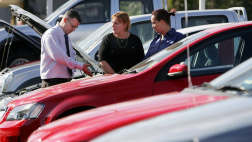The almost imperceptible hum of the electric motor and the cooling whoosh of the wind are shattered by one comment from the car's driver.
“If we built this without the proper parts or the know-how in six months, why is it taking car manufacturers so long?” says Professor Thomas Braunl of the University of WA's engineering faculty.
It's difficult to argue. Some university students and their lecturers purchased and transformed a 2008 Hyundai Getz from a petrol-fuelled hatchback to one running solely on plug-in power.
It cost $15,000 in materials _ most had to be purpose-built because the components aren't available off the shelf _ and in the real world, perhaps the same again in labour. This is in addition to the purchase of the car.
The bonus is that it costs 1.4 cents a kilometre to run _ about 10 per cent of its petrol-fuelled equivalent.
“If you recharge at night, using off-peak power, it's less than 1c a kilometre,” Professor Braunl says.
“It will charge in four to six hours and that's enough for 100km.
“As a household's second car, these are perfect. They produce no emissions, use no fossil fuels (dependant on the electricity source), are simple, quiet and reliable.”
The UWA uses roof-mounted solar cells to create electricity to run the car, making the car operate without any greenhouse gas contributions.
The conversion required removing the conventional 70kW petrol engine and its ancilliaries _ exhaust, fuel tank, cooling system and clutch _ while retaining the five-speed manual gearbox.
Under the bonnet went a 28kW electric motor and its controller, with a 144-volt lithium-ion battery pack set in a safety cage within the boot.
Despite the addition of the large battery pack and the electric motor, the Getz weighs the same as its petrol donor.
But the conversion requires some different thinking. There is very little heat from the motor so unlike a petrol engine _ where the heater and demister use the heat from the coolant _ the electric car must have an ancillary heater.
It also requires small electric motors to run the power steering and the brake system's vacuum pump. The airconditioner needs a bigger motor to operate the compressor.
Driving the car is as easy as switching on and pressing the accelerator.
Professor Braunl suggests keeping the transmission in third gear. It will accelerate as briskly as the petrol car and without needing to change gears, reach 110km/h.
A full load of passengers _ it'll take five adults at a pinch _ may require using second gear and it's possible to select fourth or fifth for country driving.
Basically, because of the inherent low-rev torque of an electric motor _ it produces maximum torque at 1rpm _ the driving characteristics are radically different to an internal combustion-engined vehicle.
A buzzer fitted to the UWA car warns of excessive accelerator pressure in an attempt to improve economy by extending the range.
A simple digital readout on the centre console acts as the fuel gauge.
“If the readout gets to about 20 per cent (of charge remaining) then you should start looking for a place to recharge,” Professor Braunl says.
While stationary, the energy consumption of the car is 0.8 amps. Use the steering and brakes and that rises to 3 amps. Turn the lights on and it becomes 4 amps and press the accelerator lightly and the drain is 75 amps. Maximum acceleration will draw 150 amps.
The DC system isn't as sophisticated as the AC units which, amongst other benefits, has the ability to accept regenerative braking energy. But the DC is simpler and significantly cheaper.
“Part of our research is to test the benefits of DC over AC. It may be that DC is more applicable to certain driving conditions than AC, for example,” he says.
The Getz was purchased new last year by the UWA without any financial assistance _ despite appeals _ from the car company. Sponsorship has come only from the WA Government's Department for Planning and infrastructure.
That hasn't deterred Professor Braunl.
“We have purchased a Lotus which will be converted with a high-performance AC electric system,” he says.
“The cost is much higher than a DC. The Getz 144-volt motor was about $3500 but the high-performance AC motor with 350-volts is about $30,000 _ it's a very big gap.
“We plan to have three cars operating at the same time _ one being built, one being tested and the other being used.
“The Getz will be sold at the end of next year. I've already had five serious bids and even requests for us to build cars.
“There's a lot of interest.”





.jpg)


.jpg)

.jpg)
.jpg)
















.jpg)
.jpg)
.jpg)




.jpg)
.jpg)








.jpg)
Comments